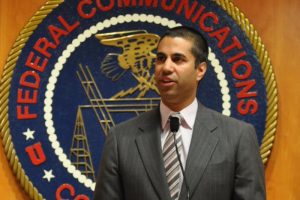
 “Welcome to a New Day!” proclaims Spectrum’s website. Like the (probably not) Chinese proverb, “May you live in interesting times”, being “new” may not be a good thing. Spectrum is the spawn of Time-Warner Cable (TWC) and Charter Communications. Do we expect that two market-dominating cable providers to produce a consumer-friendly child?
“Welcome to a New Day!” proclaims Spectrum’s website. Like the (probably not) Chinese proverb, “May you live in interesting times”, being “new” may not be a good thing. Spectrum is the spawn of Time-Warner Cable (TWC) and Charter Communications. Do we expect that two market-dominating cable providers to produce a consumer-friendly child?
 Don’t make the mistake of thinking that economists, fond as we are of markets, blindly favor the interests of business. No, we like markets because we distrust business. The 18th century’s Adam Smith noted that “People of the same trade seldom meet together, even for merriment and diversion, but the conversation ends in a conspiracy against the public.” When competition reigns in a free market economy, the competitors police one another and protect consumers.
Don’t make the mistake of thinking that economists, fond as we are of markets, blindly favor the interests of business. No, we like markets because we distrust business. The 18th century’s Adam Smith noted that “People of the same trade seldom meet together, even for merriment and diversion, but the conversation ends in a conspiracy against the public.” When competition reigns in a free market economy, the competitors police one another and protect consumers.
When there is no competition, the consumer is defenseless. And defenseless is how I feel about my choice of high speed internet service providers (ISPs), Spectrum and Frontier Telephone. It is time to strengthen regulation of ISPs.
The “new” Spectrum was formed in May, 2016. About a year before, the Department of Justice (DOJ) had effectively killed off a proposed Comcast-Time Warner merger, opening the door to a Charter merger with Time Warner Cable and Brighthouse Networks. Charter estimated that Spectrum would control 23% of the national broadband market. FYI, 30% is the magical boundary the FCC is thought to use as its informal “too-big-to-merge” threshold.
The problem with the regulators’ reasoning is twofold. First, the competitive position of these firms varies by TV/Internet/telephone. Second, the extent to which they compete in a truly national market also varies. To a large degree, the market that matters is local, not national.
Market share is measured differently in the TV business partly because services like DirecTV and broadcast serve as additional competitors. Moreover, access TV content over the Internet has to be factored in.
Even the ISP market varies. Until various wireless options evolve, broadband can only come to a building through a physical connection. In most residential communities, the only feasible physical connections are telephone wires (“twisted pair” copper wire) and cable television (delivered through “coaxial” cable). In many rural areas, twisted pair is the only physical connection.
Central business districts, however, are ripe for competition from new providers—Windstream, Verizon and others have been building new networks using fiber optic cabling, which is able to transmit 1,000 million bits per second (MBPS). Coax speed (those cable TV connections) tops out at 50 MBPS. Twisted pair copper (the “DSL” connection offered by the telephone companies) can’t deliver more than 24 MBPS using common technology. (New technology—called “G.fast”—is able to deliver fiber-like speeds over copper in specific situations and may eventually change the competitive landscape.)
The cost of rewiring a neighborhood of single family homes is prohibitive, however. So homeowners are stuck with what can be delivered over copper or coax. If you want reliable speed over 24 MBPS, you must choose between the cable company and, well, the cable company.
How much bandwidth do you need? Netflix HD will stream smoothly at 5 MBPS (download), but that assumes no one else in your household is also using bandwidth. Netflix “4k” streaming needs 15 MBPS (but 25 is better). The upload speed can also important—A video call over Skype, for example, needs bandwidth in both directions.
Given these limitation, most residential homeowners confront “duopoly”—Frontier and Spectrum for the Gardners. Without real competition, is it surprising that we get high prices and lackluster customer service? Have you ever asked what guarantees come with “up to XX MBPS download speed?” Don’t waste your breath.
 Spectrum’s post-merger ad blitz boldly promises “TV+Internet+Phone for $29.99 per month.” If you squint, however, you find “each” and “with bundled service” nestled among the words. So that comes to $90 per month (pardon me, $89.97). If, like us, you’ve “cut the cord” to TV and telephone and only want Internet, you’re stuck with the more expensive a la carte menu. I’m paying $45 per month for Internet only. Like any smart duopolist, Frontier knows that it will make more money by more-or-less matching Spectrum than by truly competing.
Spectrum’s post-merger ad blitz boldly promises “TV+Internet+Phone for $29.99 per month.” If you squint, however, you find “each” and “with bundled service” nestled among the words. So that comes to $90 per month (pardon me, $89.97). If, like us, you’ve “cut the cord” to TV and telephone and only want Internet, you’re stuck with the more expensive a la carte menu. I’m paying $45 per month for Internet only. Like any smart duopolist, Frontier knows that it will make more money by more-or-less matching Spectrum than by truly competing.
Why the “deal” on the bundles? The added cost from the added service—particularly telephone—is low, so they make more money by persuading us to buy a service we may not want or need.
Which brings me back to my main point: Until new technology permits more competition, broadband providers have too much market power in residential neighborhoods and should be regulated just like power utilities. Rochester Gas & Electric and NYSEG can’t charge any price they like—the state’s Public Service Commission must approve. That’s not perfect. Systems of price regulation are awkward and inefficient—but until consumers have the wind of competition at backs, it’s the best option.
 Some markets don’t need to be regulated. Our son just moved into a recently constructed apartment building in suburban D.C. He has a fiber optic connection right to his unit. He’s still lured into the “triple play” bundle, but is paying $70 per month for a 50 MBPS upload/50 MBPS download connection (plus TV and telephone). The fact that there are three competing providers has a lot to do with the pricing and speed. You can also get lower prices and faster speeds by moving out of the country—South Korea is the world leader in the speed/pricing value proposition. Average speed is 26 MBPS; 97% of connections are faster than 4 MBPS. The sclerotic, uncompetitive system we endure in the United States (average speed 17 MBPS) leaves us out of the top 10 of nations.
Some markets don’t need to be regulated. Our son just moved into a recently constructed apartment building in suburban D.C. He has a fiber optic connection right to his unit. He’s still lured into the “triple play” bundle, but is paying $70 per month for a 50 MBPS upload/50 MBPS download connection (plus TV and telephone). The fact that there are three competing providers has a lot to do with the pricing and speed. You can also get lower prices and faster speeds by moving out of the country—South Korea is the world leader in the speed/pricing value proposition. Average speed is 26 MBPS; 97% of connections are faster than 4 MBPS. The sclerotic, uncompetitive system we endure in the United States (average speed 17 MBPS) leaves us out of the top 10 of nations.
 The Trump Administration’s new Federal Communication Commission chair, Ajit Pai, is unlikely to help beleaguered consumers. He’s announced plans to roll back the previous administration’s plans to treat ISPs more like public utilities. The national conversation has centered on “net neutrality” rules—whether ISPs are obligated to treat all content providers the same. You can be confident, however, that if he’s opposed to net neutrality, stiffer regulation at the local level is a nonstarter. In fact, aggressive lobbying from the industry has persuaded some 20 states to restrict the ability of local governments to leash our rapacious ISPs. Congress could intervene—that’s not likely, either.
The Trump Administration’s new Federal Communication Commission chair, Ajit Pai, is unlikely to help beleaguered consumers. He’s announced plans to roll back the previous administration’s plans to treat ISPs more like public utilities. The national conversation has centered on “net neutrality” rules—whether ISPs are obligated to treat all content providers the same. You can be confident, however, that if he’s opposed to net neutrality, stiffer regulation at the local level is a nonstarter. In fact, aggressive lobbying from the industry has persuaded some 20 states to restrict the ability of local governments to leash our rapacious ISPs. Congress could intervene—that’s not likely, either.
Spectrum may be “new” but the control of a few companies over access to the Internet is anything but. Market competition is a better way to constrain profiteering—but until that’s possible for local residential providers, regulation is badly needed.
CITATION for CGR post
https://www.nytimes.com/2017/04/17/opinion/donald-trumps-multi-pronged-attack-on-the-internet.html
https://www.akamai.com/us/en/about/our-thinking/state-of-the-internet-report/